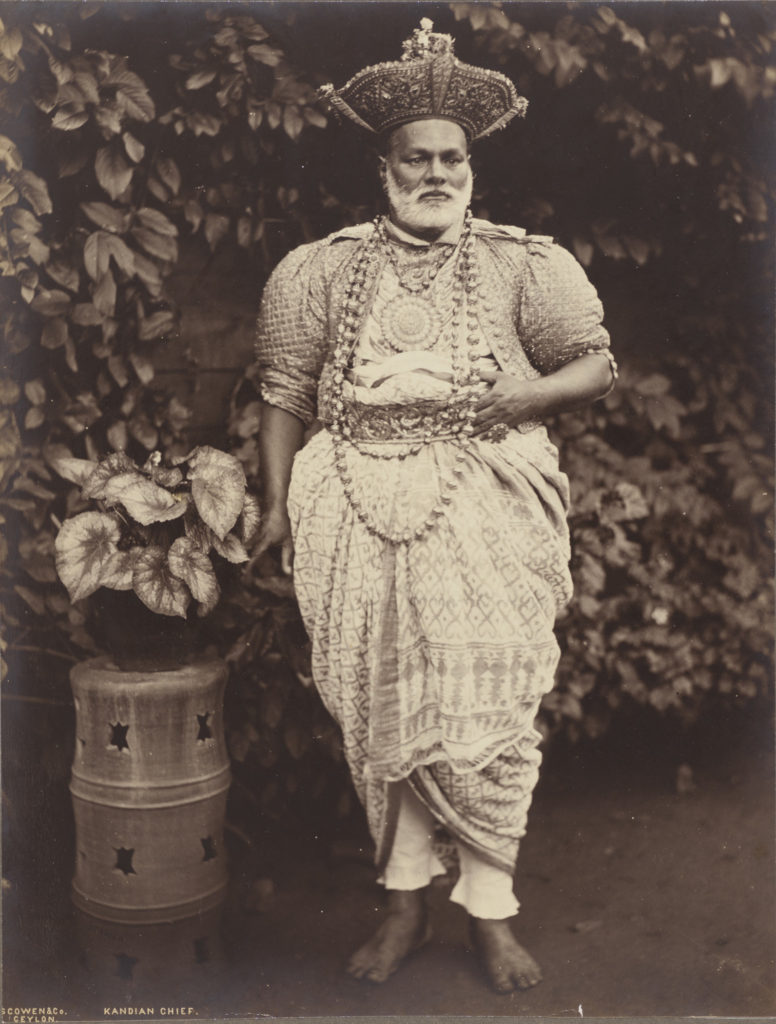
Posted in: Exhibitions
 Scowen & Co., Kandyan Chief, c. 1870, albumen silver print. Los Angeles County Museum of Art, gift of Gloria Katz and Willard Huyck, digital image © Museum Associates/LACMA
On view through June 23rd, The Jeweled Isle exhibition features over 240 works of Sri Lankan art. Serving as a visual encyclopedic presentation, The Jeweled Isle highlights art works from Sri Lanka (Ceylon). The time frame spans over the past two millennia.
Scowen & Co., Kandyan Chief, c. 1870, albumen silver print. Los Angeles County Museum of Art, gift of Gloria Katz and Willard Huyck, digital image © Museum Associates/LACMA
On view through June 23rd, The Jeweled Isle exhibition features over 240 works of Sri Lankan art. Serving as a visual encyclopedic presentation, The Jeweled Isle highlights art works from Sri Lanka (Ceylon). The time frame spans over the past two millennia.
Sri Lanka - The Jeweled Isle
Greek Mariners, traveling by ship in the 4th century BCE, nearly put Sri Lanka on the map. To the East Indians, Sri Lanka became Ratnadvipa ("Island of Gems"). Sailing through the waters of the Indian Ocean, the Greeks followed these legends of jewels. Eventually, the land of many names became Ceylon, adopted by the British from their Dutch cousins, who called the land Zeilan. In 1972, the country adopted its current name, Sri Lanka. A teardrop of an island nestled in the Indian Ocean, the promise of jeweled treasures continued its siren's call. Many heeded the call. Those who came not only found beautiful gemstones, but also fell head over heels in love with the island. Its turquoise waters, stunning coral reefs, coconut and mangrove trees, and the lush abundance of other fruit-bearing trees and shrubs. Though heavily influenced by those coming to trade with (and take) from them, Sri Lankans continued to hold fast and true to their Buddhist tradition. Over the course of 2,000 years, Sri Lankans came into their own. They established their unique approach to gem commerce and art. Today, visitors to LACMA have the opportunity to observe the continuity of Sri Lankan traditions. A story told through hundreds of works of art in their Jeweled Isle exhibition.The Opening Gallery
At the foundation of this exhibit are 42 works from LACMA's South and Southeast Asian department. Added to this are another 200+ borrowed pieces, including photographs, textiles, furnishings, sculptures. They also borrowed 21 unmounted gemstones from the Natural History Museum. The Jeweled Isle exhibit opens with these 21 gemstones displayed in a glass case. They represent the types of gemstones mined in Sri Lanka from ages past until now. These include, but are not limited to, sapphire, ruby, chrysoberyl, alexandrite, topaz, citrine, moonstone, and amethyst. The most important of these gemstones remains blue sapphire. Additionally, this section of the exhibit includes sacred works. Though primarily a Buddhist nation, Sri Lanka maintains a long tradition of incorporating the religious narratives of their neighbors and fellow tradesmen. The 14 shrine panels on display epitomize this practice, with their depiction of many Hindu gods and demons.Three Important Time Periods
Throughout the exhibition, the notion of jewels ranges from decorative objects made from ivory, gold, and silver, to the photographic record of Sri Lanka's monuments, geography, feasts and festivals, royalty, and more. Passing beyond the masks and vessels used in religious rituals and festivals, the remainder of the exhibition centers on three distinct time periods. First of all, the 3rd century BC to the 10th century AD, when Buddhism came to Sri Lanka. Second, the 11th through the 13th centuries, demonstrated by works that demonstrate the inclusion of Hinduism into Sri Lankan Buddhism. Finally, the 15th through 19th centuries. During this time, the Dutch, Portuguese, and British influenced Sri Lankan art through trade and imperialism. In the final gallery, a contemporary Buddhist work sits across from a similar work from the 18th century, which features a 3-foot long reclining Buddha. Conceptualized and made by Lewis DeSoto, the modern piece, "Paranirvana (Self-Portrait)" stretches across 26 feet of floor space. Fashioned from painted black cloth, the statue remains inflated during museum hours thanks to an industrial fan. Serving as a visual statement to the impact of the Buddha's influence, the piece was inspired by a 12th century stone carving. This inspirational reclining Buddha resides at Gal Vihara in Polonnaruwa. On the walls of this gallery also hang photographs of mid-century life in Sri Lanka. These were taken after they gained their independence in 1948. Taken by Reg van Cuylenberg, a Sri Lankan photographer, these images catalog his tours across the island in 1949 and 1958. His love for his country and his images of festivals, local life, and landmarks important to him and his people provide the perfect conclusion to this exciting exhibition. To plan your visit, I invite you to visit LACMA'S website. ~by Angela Magnotti Andrews5 years ago
0 view(s) 